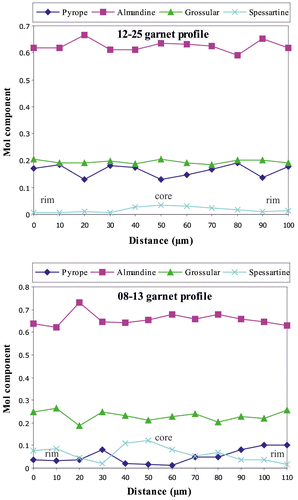Abstract
The Biga Peninsula in northwest Turkey contains high-pressure metabasic eclogite that occur in two localities; as lenses within a 2 km long, 500 m thick quartz-phengite schist slice that is in turn found in the greenschist-facies metasedimentary rocks of the Çamlıca metamorphics, in Çamlıca area, and in two north-south elongated eclogites occurring as a tectonic slice between Kazdağ Massif and Çetmi Group, in Çetmi area. The P-T conditions under which these two exposures of eclogites formed are important to quantify the tectonic processes of subduction, exhumation and emplacement that high-pressure rocks of the Biga Peninsula record. New geochemical data suggest that both protoliths were N-type MORB basalt with high TiO2 and K2O–Na2O content and Nb/Y ratios. Most eclogite samples have tholeiitic signatures volcanic arc settings. ∑REE abundances range from 47.55 to 107.4 ppm. Europium anomalies are slightly variable (Eu/Eu* = 0.9–1.1) and trace element contents are similar to typical MORB based on tectonic discrimination diagrams. All eclogite protoliths were probably derived from depleted mantle source, modified by fluids within the subduction zone. The high-P mineral assemblage in eclogites from both regions is omphacite + garnet + glaucophane + phengite + epidote + zoisite + quartz. The inclusions in garnet are glaucophane, quartz, phengite, Ca-amphibole and rutile. P-T conditions are similar to each other and constrained at 550–700 °C and 16–24 kbar. Geochemical data and mineral chemistry indicate that the eclogites in the Biga Peninsula represent oceanic crust processed at significant depths (50–80 km) within the subduction channel and were juxtaposed with greenschist facies as a tectonic slice in the accretionary complex at higher structural levels.
1. Introduction
Eclogites are common in the Alpine-Himalayan orogenic system (Okay, Satır, & Siebel, Citation2006 and references therein) and contain very important information for the investigation of the tectonic processing of subducted material and subsequent collision that constructs continental crust. Metabasite that display eclogite assemblages occurs as lenses and/or blocks of variable size within low to high-grade metasediment in northwest Turkey. These rocks are of special interest that they are not only marking the locations of former subduction, but also providing information on deep-seated tectonic processes. High-P assemblages are most widely recognized in rocks with basaltic protoliths, as these mafic rocks tend to preserve high-pressure assemblages relative to non-mafic rocks (e.g. felsic gneisses and metapelites, Koons & Thompson, Citation1985) due to the diversity of chemical components in mafic compositions, kinetic and equilibrium reasons. The disparity of recorded P-T conditions between metabasaltic protoliths and felsic or pelitic host rocks typically results in conflicting possible tectonic interpretations of eclogites (e.g. Smith, Citation1988), specifically whether host-metasediments were present with the mafic rocks during high-pressure metamorphism or whether the eclogites were tectonically emplaced into low-grade metasediments (Di Vincenzo, Palmeri, Talarico, Andriessen, & Ricci, Citation1997; Şengün, Yigitbas, & Tunç, Citation2011). Furthermore, most eclogite can store the geochemical trace of protolith in spite of tectonic and metamorphic reworking during high-P metamorphism.
Anatolia is situated at the interface of the Africa and Eurasian plates, and has been assembled through numerous subduction and collisional events since Early Mesozoic. The Biga Peninsula in northwest Turkey hosts exposures of high pressure – low-temperature (HP/LT) rocks that have variable greenschist-facies overprinting (Figure ). Okay, Siyako, and Bürkan (Citation1990) were the first to report eclogite-facies metamorphism from the Biga Peninsula. Later, Okay and Satır (Citation2000a, Citation2000b) confirmed the presence of omphacite through microprobe analysis. However, the origin and tectono-metamorphic evolution of the Biga Peninsula is not clearly understood, although these eclogite have been interpreted as related to subduction (Okay & Satır, Citation2000a, Citation2000b; Şengün et al., Citation2011). Metamorphic conditions of eclogites have been also poorly constrained due to the use of classical geothermobarometers. In this paper, we present new data on geochemical characterization and P-T evolution of fresh eclogite samples from localities on the western and southern part of the Biga Peninsula that provide new insights into the extent of subduction processes in northwest Turkey.
Figure 1. Simplified tectonic map of the Eastern Mediterranean region indicating the major geotectonic units and the bounding sutures (modified from Meinhold, Kostopoulos, Frei, Himmerkus, & Reischmann, Citation2010; Okay et al., Citation2006).
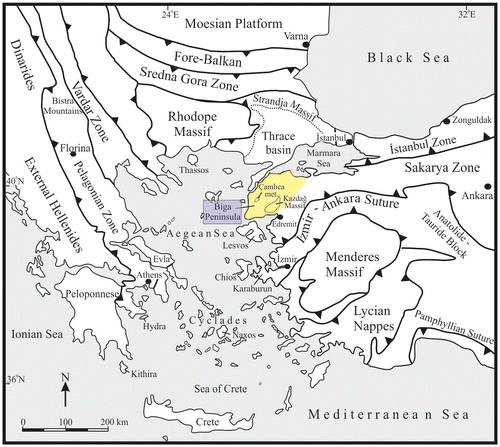
2. Geological setting
The Biga Peninsula at the western end of the Sakarya Zone is bordered to the north by the Strandja Massif and the Thrace Basin, and the Aegean Sea marks the western and southern borders (Figure ). The Biga Peninsula in NW Turkey is characterized mostly by plutonic and associated volcanic rocks, ophiolites and amphibolite to granulite facies metamorphic rocks. Therefore, the Biga Peninsula includes the following main units: (1) amphibolite to granulite facies basement rocks of the Kazdağ Massif and Çamlıca metamorphics with high-P assemblages (Cavazza, Okay, & Zattin, Citation2009; Duru, Pehlivan, Şentürk, Yavaş, & Kar, Citation2004; Okay & Satır, Citation2000a, Citation2000b; Şengün & Çalık, Citation2007; Şengün et al., Citation2011; Yaltırak & Okay, Citation2004) and Kemer metamorphics (Aygül, Topuz, Okay, Satır, & Meyer, Citation2012; Beccaletto, Bonev, Bosch, & Bruguier, Citation2007), (2) the Triassic-Early Jurassic units of the Karakaya Complex cropping only out in the eastern part of the Biga Peninsula (Okay & Göncüoğlu, Citation2004), (3) subduction-accretion related Çetmi mélange with high-P assemblages (Beccaletto, Bartolini, Martini, Hochuli, & Kozur, Citation2005; Okay et al., Citation1990), (4) the Permo-Triassic Ezine Group that is tectonically overlain by the Lower Cretaceous Denizgören ophiolite (Beccaletto & Jenny, Citation2004) and (5) Tertiary sedimentary cover units that unconformably overlie all of the units mentioned above (Figure (a)).
Figure 2. (a) Generalized geological map of the Biga Peninsula (modified from Okay & Satır, Citation2000a). Inset map shows location of the Biga Peninsula. (b) Detailed geological map of high-P tectonic slice (Şengün et al., Citation2011). (c) Detailed map of the Çetmi Group (After Tunç, Citation2008; Yiğitbaş et al., Citation2009a).
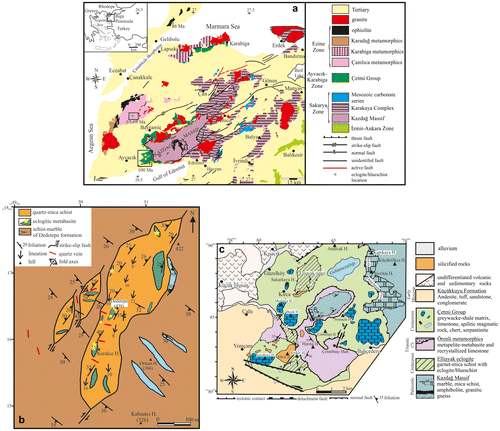
High-P metamorphic rocks crop out in the Çamlıca metamorphics and beneath the Çetmi Group as a tectonic slice (Yiğitbaş, Şengün, & Tunç, Citation2009a; Yiğitbaş, Tunç, & Şengün, Citation2009b; Figure (a)). The Çamlıca metamorphics occur in the westernmost part of the Biga Peninsula and are tectonically separated from the Denizgören ophiolite in the west by the Ovacık fault (Okay & Satır, Citation2000a). The Çamlıca metamorphics are subdivided into three formations, from bottom to top; the Andıktaşı formation, the Dedetepe formation and the Salihler formation. The Andıktaşı formation comprises metalava and metatuff and is overlain by the Dedetepe formation consisting of garnet-muscovite schist, garnet–albite-chlorite schist, albite-epidote-chlorite schist, marble and calc-schist. The Salihler formation conformably overlying both the Andıktaşı formation and Dedetepe formation is mainly composed of phyllite, calc-schist and marble intercalations. Eclogite-facies metamorphic rocks occur as tectonic lenses within schist-marble intercalations of the Dedetepe formation. The host rocks, the Çamlıca metamorphics, record only a single stage of greenschist-facies metamorphism and were juxtaposed with the eclogite-facies metamorphic rocks along ductile–semi-brittle strike-slip faults after eclogite-facies metamorphism and during or after the low-grade metamorphism of the Çamlıca metamorphics (Şengün et al., Citation2011). Metabasite lenses with eclogite assemblages experienced HP/LT metamorphism at a minimum pressure of 11 kbar and at a temperature of 510 ± 50 °C based on the jadeite content of omphacite and the garnet-clinopyroxene Fe-Mg partitioning, respectively (Okay & Satır, Citation2000a). Rb–Sr phengite ages of eclogite-facies rocks in the Çamlıca metamorphics range from 65 to 69 Ma, which is interpreted as the age of HP/LT metamorphism (Okay & Satır, Citation2000a).
The Çetmi Group found on the southern part of the Biga Peninsula is mainly composed of various types of blocks within a detritic matrix. Outcrops of eclogite are seen as a tectonic slice between the Kazdağ Massif and Çetmi Group (Yiğitbaş et al., Citation2009a, Citation2009b). These large tectonic slices of eclogites and eclogitic garnet-micaschist represent pieces of a former oceanic crust (Figure (c), Beccaletto et al., Citation2005; Okay & Satır, Citation2000b). The rocks in the Çetmi Group mainly consist of spilitized mafic volcanic rocks, blocks of Upper Triassic neritic and pelagic limestones, greywacke-shale matrix, minor radiolarian chert and serpentinite/listvenite slices (Beccaletto, Citation2004; Beccaletto et al., Citation2005) and are unmetamorphosed. The Çetmi Group is unconformably overlain by various types of Neogene sedimentary and volcanic rocks. Garnet-clinopyroxene Fe–Mg thermometry revealed temperature of 480 ± 50 °C at a pressure of 10 kbar for omphacite-garnet pairs. Rb–Sr phengite ages from two eclogite samples in the Çetmi region gave a Lower Cretaceous age of ~100 Ma (Okay & Satır, Citation2000b). The same age has been found by Lips (Citation1998), which also dated eclogite using 40Ar/39Ar method on white mica, which is interpreted as a cooling age (Lips, Citation1998; Okay & Satır, Citation2000b).
3. Field occurrences and relationships of the eclogite bodies
Various types of high-P rocks including eclogites, blueschist, quartz-phengite schist and garnet-mica schist are found within both the Çamlıca metamorphics and beneath the Çetmi Group located on the western and southern part of the Biga Peninsula, respectively. The Çamlıca eclogites occur as lenses within a 2 km long, 500 m thick quartz-phengite schist slice in the schist-marble intercalation of the Dedetepe formation of the Çamlıca metamorphics (Figure (b)). Metabasite lenses with eclogite assemblages also contain amphibolite, tremolite/actinolite schist and talc schist, which show deformation trails with retrogressed assemblages. Eclogite lenses are elliptical, approximately 100 m long, weakly foliated, with heterogeneous textures. These lenses display banding of thin alternation green omphacite-rich layers and blue glaucophane-rich layers, which are referred to herein as eclogite and blueschist, respectively. Blueschist locally retrogressed from eclogite assemblages along shear zones that formed under ductile-semi-brittle conditions during strike-slip displacement (Şengün et al., Citation2011). This tectonic contact is deformed by a mesoscopic isoclinal fold observed at multiple sites in the field. Eclogites are generally aligned parallel to the associated E/NE-trending quartz-mica schist. The quartz-phengite schist is white-colored, well-foliated and homogeneous rocks. High Si contents of white mica show that quartz-phengite schist within the tectonic slices experienced HP metamorphism (Okay & Satır, Citation2000a). The host rocks are mainly mica schist and marble that indicate no evidence of high-P metamorphism and include greenschist-facies assemblages (Şengün et al., Citation2011).
Two north–south elongated outcrops of eclogite and associated garnet-mica schist occur beneath the Çetmi Group, in a tectonic contact with both the Kazdağ Massif and Çetmi Group (Tunç, Citation2008; Yiğitbaş et al., Citation2009a; Figure (c)). These two exotic tectonic slices of eclogites and associated garnet-mica schist are 2–3 km long and less than 1 km thick. Eclogites are green-colored, massive and fine to medium grained with banded textures. Some eclogites show prominent variation with increasing degree of retrogression of the eclogite assemblages from least at the center to greatest at the edge. The garnet-mica schist form well-foliated, coarse-grained, silvery gray homogenous rocks with horizons of eclogite, which are variably altered to blueschist. Eclogites are locally retrogressed to blueschist along shear zones. The foliation in the eclogite-mica schist is NW/SE-trending and parallel to the elongation axis of the eclogite slices. Their surrounding rocks are composed of metabasites with greenschist-facies assemblages.
4. Petrography
The mafic lenses with eclogite assemblages and associated metasedimentary rocks described in this paper are found in both Çamlıca metamorphics and beneath the Çetmi Group. The typical eclogites were investigated in terms of textural and mineralogical evidence. The term eclogite is applied to rocks with modal contents of garnet and omphacite of more than 70% (Carswell, Citation1990). Estimated modal abundances of representative rock samples are given in Table .
Table 1. Estimated modal abundance of the representative rock samples from the Çamlıca metamorphics and Çetmi Group.
Eclogite mineral assemblages are preserved in metabasite lenses within the Çamlıca metamorphics that have undergone extensive greenschist facies retrogression (Şengün et al., Citation2011). The high-P assemblages in eclogite consist of omphacite + garnet + epidote + glaucophane + quartz + phengite (Figure (a)). Typical accessory minerals are rutile, zircon and sphene. Major textural differences in eclogite are related to the intensity of foliation and lineation, and the grain size of garnet. Euhedral, relatively large (2–8 mm) porphyroblasts of garnet, are scattered through a fine-grained matrix, and contain inclusions of mainly quartz, epidote, phengite, glaucophane, Ca-amphibole and rutile (Figure (b)). The continuity between inclusion and matrix lineation exhibits syn-tectonic growth of garnet during the eclogite-facies metamorphism. Due to greenschist-facies overprint, some garnets are partially replaced by Ca-amphibole (Figure (c)).
Figure 3. Photomicrographs of typical eclogite paragenesis and textures. (a) Eclogitic paragenesis with garnet, omphacite, glaucophane and phengite from the Çamlıca metamorphics. Prismatic omphacite and glaucophane crystals are oriented parallel to the foliation. Plane polarized light (PPL). (b) Garnet porphyroblasts contain glaucophane, phengite, quartz, Ca-amphibole and rutile inclusions. PPL. (c) Garnet porphyroblasts are replaced by Ca-amphibole. PPL. (d) Quartz-phengite schist associated with eclogite. Crossed polarized light (CPL). (e) The general texture of eclogite from the Çetmi Group. PPL. (f) Garnet-mica schist associated with eclogite. CPL. Abbreviations after Whitney and Evans (Citation2010).
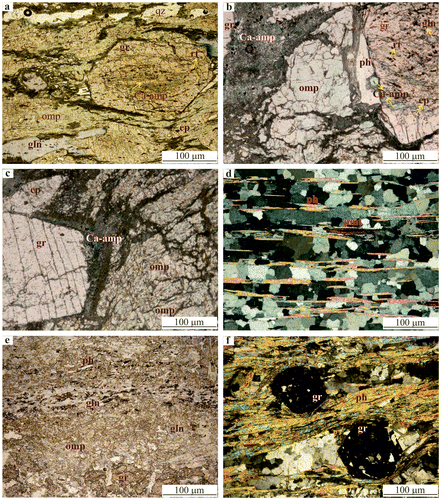
Omphacite is finely grained and forms up to 2 mm long crystals in the matrix. They are widely enclosed by rims of calcic amphibole developed during retrograde overprint. Sodic- amphibole in eclogite is glaucophane in composition, and is typically fine grained and aligned with omphacite in the matrix (Figure (a)). Glaucophane is commonly elongated with tiny sphene inclusions. Glaucophane crystals are rimmed and partially replaced by Ca-amphibole. Glaucophane inclusions in garnet also show that glaucophane was present as a matrix phase in the eclogite stage. Phengite occurs in the matrix as 10–20 μm elongated flakes that define the main foliation, and as inclusions in garnets. The grain-boundary shapes among the high-P phases suggest textural equilibrium during eclogite-facies metamorphism.
Most rutile grains are mantled by titanite. Ca-amphibole and chlorite occur in eclogite as secondary phases that are not equilibrium with the high-P phases. Chlorite is texturally late, indicative of breakdown, and replaces garnet and omphacite. Tourmaline is an accessory phase and locally very abundant in some eclogites and is typically aligned with the matrix foliation.
Along late-stage shear zones, eclogite is locally transformed into blueschist. The blueschist is fine grained with 0.5–2 cm long crystals of blue amphibole and comprise garnet + glaucophane + epidote + chlorite ± phengite ± quartz with accessories titanite + rutile + calcite. Glaucophane crystals are oriented due to shearing. In these shear bands, omphacite is almost completely replaced by glaucophane. Based on textural and mineralogical data, glaucophane in eclogites may have formed due to retrograde shearing in blueschist conditions, or that glaucophane was in stable coexistence with omphacite during eclogite-facies metamorphism (Şengün et al., Citation2011).
Quartz-phengite schist associated with eclogite is composed of quartz + phengite + garnet + piemontite + chlorite (Figure (d)). These rocks include quartz-rich layers and may represent metamorphosed ribbon chert. On the other hand, the host rocks, schist-marble intercalation of the Çamlıca metamorphics, contain the index minerals albite-epidote-chlorite indicating greenschist-facies metamorphism with neither mineral nor textural relics of high-pressure event. The index minerals show that Çamlıca metamorphics were subjected to a single stage of greenschist-facies metamorphism.
The eclogites from the Çetmi region are mainly composed of colorless to bright green omphacite up to 1 mm in size and pink-colored garnets up to 3 mm in size. The eclogites are strongly fractured in places. These fractures are filled with secondary minerals including calcite, quartz and chlorite. The high-P mineral assemblage of eclogites is mainly composed of garnet + omphacite + glaucophane + epidote + phengite + quartz + rutile (Figure (e)). Phengite, epidote, quartz and glaucophane are textural equilibrium with garnet and omphacite. Garnets in the eclogites are mostly euhedral with grain size of about 0.8 up to 3 mm. Small inclusions of Ca-amphibole, glaucophane, quartz, phengite, rutile and titanite are enclosed in garnets. Well-preserved euhedral garnets grains have sharp grain boundaries with omphacite. Garnets are replaced by chlorite along rims and fractures. Omphacite forms up to 1 mm long crystals that impart a strong compositional layering and is partially replaced by Ca-amphibole. Straight grain boundaries between omphacite and glaucophane suggest textural equilibrium. Glaucophane is lavender blue crystals and has rims of bluish-green edenite-actinolite. Glaucophane and phengite occur as aligned elongated crystals that define foliation and lineation. Epidote is found as aggregates of grains up to 0.3 mm in size. Rutile occurs as grains in the matrix and inclusions in garnets. It is commonly rimmed by titanite and ilmenite.
The eclogites were transformed into blueschists along late-stage shear zones (Şengün et al., Citation2011). The blueschist mineral assemblage is made up of garnet + glaucophane + epidote + Ca-amphibole ± quartz ± titanite ± zircon. Glaucophane occurs as oriented crystals along shear zones. The mineral assemblage in the garnet-mica schist associated with eclogite is garnet + quartz + phengite + biotite ± calcite ± zircon (Figure (f)). The eclogites show greenschist-facies overprint with the development of interstitial albite, partial replacement of garnet by epidote and chlorite, titanite rims around rutile and Ca-amphibole rims around glaucophane.
5. Analytical methods
Fresh high-P rock samples were collected from the Çamlıca metamorphics and Çetmi Group, taking care to avoid weathered, hydrothermally altered or mineralized pieces. Seventeen representative samples were selected and analyzed for major, trace and rare earth elements (REE) chemical composition (Figure ). Whole-rock analyses were performed by analytical facilities at the ALS Chemex Laboratory in Canada. Major oxides were determined by Inductively Coupled Plasma–Atomic Emission Spectroscopy (ICP-AES). Trace element and REE concentrations were analyzed by Inductively Coupled Plasma–Mass Spectroscopy. The prepared sample (0.200 g) was added to lithium metaborate/lithium tetra borate flux (0.90 g), mixed well and fused in a furnace at 1000 °C. The resulting melt was then cooled and dissolved in 100 mL of 4% nitric acid 2% hydrochloric acid. This solution was then analyzed by ICP-AES and the results were corrected for spectral interelement interference. The oxide concentration was calculated from the determined elemental concentrations.
Mineral compositions were performed using JEOL 8900 Electron Microprobe in the Department of Geology and Geophysics at the University of Minnesota. Operating conditions were 20 kV accelerating voltage and a 15 nA beam current. Natural and synthetic minerals were used for standardization. Raw data were corrected with the ZAF procedure. Representative mineral compositions of garnet, clinopyroxene and amphibole are given in Table –.
Table 2. Representative microprobe analyses of garnet in eclogite.
Table 3. Representative microprobe analyses of clinopyroxene in eclogite.
Table 4. Representative microprobe analyses of amphiboles in eclogite.
6. Geochemistry
Whole-rock major and trace element data for nine selected eclogites (five eclogites from the Çamlıca region: 07–21, 07–33, 05–102, 08–39, 09–80, four eclogites from the Çetmi region: 07–34, 08–08, 08–08/5, 08–13) are reported in Table . Major, trace and REE compositions of eclogites from the Biga Peninsula have been determined to reveal their protolith, source area and tectonic setting. Eclogites from the Çamlıca and Çetmi regions are characterized by low SiO2 (46–48.9 wt.%), high TiO2 (1.12–2.49 wt.%), K2O+Na2O (2.61–3.7 wt.%, Na2O>K2O) contents and high Cr (30–400 ppm), Nb (1.4–16.5 ppm) contents.
Table 5. Major and trace element compositions of eclogites from the Biga Peninsula.
Eclogites indicate the following trace element characteristics: (1) high contents of incompatible elements (e.g. Nb, Y, Zr) and high Nb/Y ratios, (2) high Cr (up to 400 ppm), V (284–450 ppm) and Ni (<170 ppm) concentrations. Whole-rock geochemistry of the eclogites suggests that their protoliths were normal mid-ocean ridge basalts (N-MORB) basalts (Figures (a) and (a)). In the FeO–Na2O+K2O–MgO diagram of Irvine and Baragar (Citation1971), eclogites plot in the tholeiitic field (Figure (b)).
Figure 4. (a) Rock classification diagram of metavolcanic rocks from the Biga Peninsula (after Pearce, Citation1996). (b) FeO–Na2O+K2O–MgO diagram (Irvine & Baragar, Citation1971).

Figure 5. (a) N-type MORB-normalized (normalization values are from Sun & McDonough, Citation1989) and (b) Chondrite-normalized REE patterns of the eclogites. Chondrite normalizing values from Taylor and Mc Lennan (Citation1985). Most samples show typical MORB patterns.
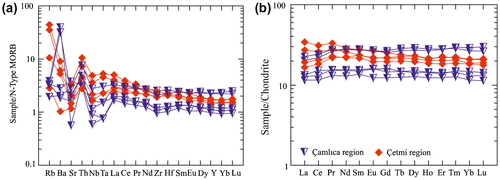
The N-type MORB-normalized multi-element spider diagram for eclogites is shown in Figure (a). The N-type MORB-normalized trace element patterns of eclogites are characterized by relatively flat high field strength elements with negative Sr anomaly and large negative Nb anomaly, which exhibits depleted-mantle source in the subduction zone (Figure (a)). Rubidium, in particular, shows a wide scatter. Most Th and Ce abundances are enriched compared to neighboring elements. Thorium abundances vary considerably between samples, and high Th/Nb ratios are seen in eclogite samples. These features also indicate either a subduction signature or crustal contamination (Pearce, Citation1996; Stern, Syme, & Lucas, Citation1995). Moreover, all eclogite samples display patterns similar to the present-day N-type MORB (Sun & McDonough, Citation1989).
REE are known to be the least mobile elements during hydrothermal alteration and eclogite-facies metamorphism (Bernard-Griffiths, Peucat, Cornichet, Iglesias Ponce de Leon, & Iberguchi, Citation1983; Michard, Citation1989; Peate, Citation1997). Therefore, the chondrite-normalized REE diagrams give valuable insight into the source of the magmas and their crystallization evolution. Chondrite-normalized REE diagrams illustrate that the eclogites from the Biga Peninsula generally have a flat REE patterns (Table ; Figure (b)) and Europium anomalies are slightly variable (Eu/Eu* 0.9–1.1).
Table 6. REE compositions of eclogites from the Biga Peninsula.
7. Mineral chemistry
7.1. Garnet
Garnet formulae usually show cation totals just less than 16.00 per 24(O). Representative analyses are given in Table . Garnets from eclogite from a tectonic slice in the Çamlıca metamorphics mainly display almandine-grossular rich composition with Al58–65, Grs17–30, Prp6–19, Sps1–3 mol%. Garnets from the Çetmi region are also almandine-grossular rich with Al61–73, Grs18–24, Prp1–17, Sps0.9–12 mol%. Garnet composition of these eclogites fits the C-type of Coleman, Lee, Beatty, and Brannock (Citation1965) classification (Figure (a)), typical of eclogites occurring in subduction complexes. These C-type eclogites are commonly associated with blueschist.
Figure 6. Mineral chemistry plots of garnets and omphacites. (a) Chemical composition of garnets in an Alm + Sps–Grs + An-Prp diagram. Divisions into groups A, B, C according to Coleman et al. (Citation1965). (b) Plot of omphacite in a triangular diagram after Morimoto et al. (Citation1988). Quad represents the Ca-Mg-Fe pyroxene area.
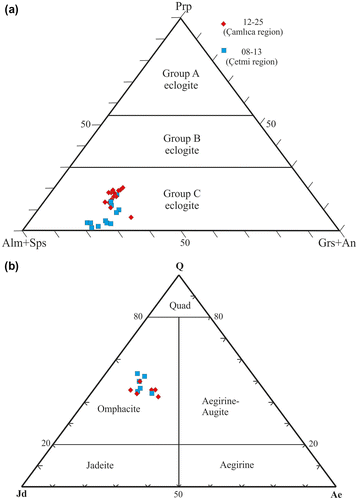
The zoning characteristics of the eclogitic garnets from the Çamlıca and Çetmi regions are shown in Figure (a) and (b), respectively. Garnets from both regions have similar features and almost flat compositional profiles with a slight increase in pyrope and grossular with a decrease in spessartine components from core to rim (Figure (a) and (b)). The increase in pyrope, grossular and the decrease in spessartine components from core to rim of the garnets typically suggest growth zoning during prograde metamorphism. The higher almandine and lower pyrope component in the garnet of eclogite from the Biga Peninsula is linked to the bulk rock chemical composition of the protoliths (Mposkos, Baziotis, & Proyer, Citation2012). The zoning was probably controlled by reactions taking place during garnet growth rather than subsequent diffusion (Carswell, Citation1990). Such zoned garnets are common in eclogites that have formed at temperatures between 550 and 700 °C (e.g. Krogh, Citation1980).
7.2. Clinopyroxene
Clinopyroxene compositions were recalculated to 6.00 cations with Fe+3 estimated by stoichiometry. Representative analyses are given in Table and selected analyses have been plotted on the Jadeite-Aegerine-Quad (Quad includes: wollastonite, diopside, hedenbergite, enstatite, ferrosilite) diagram of Morimoto et al. (Citation1988). All of these clinopyroxenes plot in the omphacite field (Figure (b)). The omphacite from eclogite samples in the Çamlıca region have Jd35–43, Ae12–22, Q42–49 mol% and Na2O contents up to 8 wt.%. However, the composition range of omphacite from the Çetmi region is similar: Jd34–40, Ae9–18, Q44–54 mol% and Na2O content up to 8 wt.%. The acmite component (12–22 mol%) in clinopyroxene of eclogite from the Çamlıca region is slightly higher than that in clinopyroxene of eclogite from the Çetmi region.
7.3. Amphibole
Representative amphibole analyses are given in Table . Amphiboles in eclogites from the Çamlıca and Çetmi regions have mainly compositions that correspond to Na-amphibole which are associated with their metamorphic evolution (Figure (a)). In eclogites from the Biga Peninsula, amphibole inclusions in garnet and matrix amphibole occur in textural equilibrium with omphacite are glaucophane with Si 7.8–7.9 a.p.f.u (atoms per formula unit) and NaB 1.6–1.9 a.p.f.u (Figure (b)). On the other hand, green to bluish amphiboles formed in a post-eclogite stage have variable chemistries ranging from Na-Ca- amphibole (richterite) through Ca-amphibole (actinolite, edenite, pargasite) with Si 6.4–6.5 a.p.f.u, NaB 0–0.08 a.p.f.u and Si 7.7–7.8 a.p.f.u, NaB 0.77–0.85 a.p.f.u, respectively (Figure (a)).
Figure 8. (a) Chemical composition of amphiboles in a NaB versus Si diagram. (b) Na-amphibole analyses from eclogites in the diagram of Leake et al. (Citation1997).

7.4. Mica
White mica in eclogites from both areas are phengite with Si values ranging from 3.06 to 3.54 a.p.f.u. Phengite as a common mineral in the matrix and as inclusion in garnet formed during eclogite-facies metamorphism. The chemical composition of phengites in eclogite from the Çamlıca region can be given as Fe+2/Mg ratio = 0.40–0.61, Na/(Na+K) ratio = 0.06–0.12. However, phengites from the Çetmi region yield Fe+2/Mg and Na/(Na+K) ratios range from 0.36 to 0.59 a.p.f.u and from 0.11 to 0.12 a.p.f.u, respectively. Moreover, high white mica Si contents from quartz-mica schist within the high-P tectonic slices showing high-pressure metamorphism have been reported from the Çamlıca region (Okay & Satır, Citation2000a).
8. Phase equilibria and P-T conditions
Using the phase diagram calculation software package Perple_X (Connolly, Citation1990, Citation2005, version 6.6.6) and the thermodynamic database of Holland and Powell (Citation1998, with updates), phase diagrams for specific bulk compositions (pseudo-sections) were calculated for two eclogite samples and contoured for selected mineral components and modes. The system Na2O–CaO–K2O–FeO–MgO–Al2O3–SiO2–H2O (NCKFMASH) describes the rocks, with the significant exception of Fe3+, which was not measured in the bulk composition, although it is present in glaucophane, omphacite, epidote and biotite and can occur in phengite (Table ). The projected parameters included: calcic-amphibole modal weight percent, composition of jadeite in clinopyroxene and XGrs in garnet, and a fraction of the mineral composition of Na/Ca in amphibole was used to identify the P-T distribution of sodic- and calcic-amphiboles.
Calculation of phase diagrams requires making assumptions about thermodynamic models (activity-composition relations) and the chemical system. In particular, zoisite was used as a proxy for epidote because of uncertainties in accounting for Fe3+ in solution models. The major element K was included to model the occurrences of biotite and phengite. The minor elements Mn and Ti were not used in the calculations because spessartine in garnet is low and Ti is concentrated in accessory phases. Furthermore, the analysis considers only phases that appear to be primary or texturally related to fabric forming event, not texturally very late retrograde assemblages that include chlorite. Finally, the assumption of the fluid composition of aH2O = 1 was chosen for the presence of hydrous phases in the samples and the fact that preliminary models with CO2 showed only the stability of dolomite which was not observed in or near the units sampled, even with the mass of carbonate host rock in the field setting.
The phase diagrams are constructed assuming that the calculated bulk composition represents the effective bulk composition of the rock. Retrograde textures were clearly defined and minor such as calcic-amphibole that has grown at the expense of sodic-amphibole in sample 12–25. We therefore present one phase diagram for each sample and use the isopleths for zoned phases to infer the range of P-T conditions under which the sample may have equilibrated, and infer a P-T trajectory from what little evidence is there from inclusions and inference from the subduction-related tectonic setting.
8.1. Sample 12–25 (Çamlıca region)
This sample contains omphacite + garnet + phengite + Na-amph + Ca-amph + epidote + zoisite + quartz + rutile + titanite. The bulk composition, typically mafic igneous, shown in Table and the normalized bulk composition used is shown on Figure (a). The observed assemblage of sample 12–25 is projected to occur in field 21 (Table ) along a narrow window of conditions that stretches from approximately 22 kbars, 550 °C to 16 kbars, 675 °C (Figure (a)), herein referred to as the stability field 21. Several compositional constraints predicted by pseudo-section that compare closely to the observed electron microprobe analyses add support to the identified field on the pseudo-section as being the P-T region of equilibration.
Figure 9. (a) Sample 12–25 (Çamlıca region). The stability conditions shown in field 21 for this eclogite sample were constrained by the observed assemblage of omp + grt + ph + Na-amp + Ca-amp + ep + zo + rt + qz. isopleths of XJd, XGrs and wt.% Ca in amphibole using the NCKFMASH system. (b) Sample 08–13 (Çetmi region). The stability conditions shown in fields 13–14 for this eclogite sample were constrained by the observed assemblage of omp + grt + ph + Na-amp + ep + zo + rt + qz. Isopleths of XJd, XGrs and ratio of wt.% Na/Ca in amphibole using the NCKFMASH system. The reaction curves are calculated with the software PERPLE_X and database of Holland and Powell (1990).
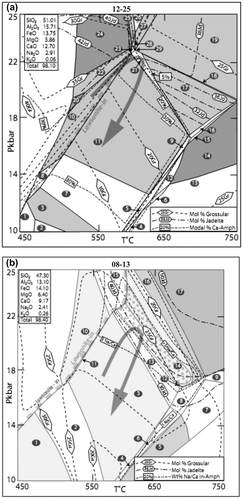
Table 7. Mineral assemblages belong to numbers of the equilibrium curves on a phase diagram (Figure ).
The mol% of jadeite component (XJd) in pyroxene from microprobe analyses varies from 35–43Jd. 30–40Jd isopleths truncate within stability field 21, 35–40Jd, in particular, terminate at the high-P, low-T end of the window of stability, note that the omphacite-out line is the lower P-T wall of the stability field 21 (Figure (a)). Although there is no clear textural evidence to suggest a previous generation of discrete sodic-pyroxene growth, the existence of higher jadeite content from 40–43Jd suggests that these may have grown in fields that have lawsonite stable (lawsonite-in shown as a thick transparent dashed line), but have similar pressures as those of the stability field 21, however no lawsonite was observed within the analyzed samples.
Mol% grossular (XGrs) component in garnet varies between 17Grs and 30Grs, however most analyses cluster around 20%. The approximate location of the conditions that could generate these 20Grs isopleths lie at lower P-T than stability field 21, particularly 50 °C and 2–4 kbars lower and along the lawsonite-in line in field 10, and fields 4, 5, 6 and 12 (Figure (a)). The presence of an analysis of near mol 30% grossular suggest that garnet grew near the lawsonite-in line (thick transparent dashed line) in a similar location to that of the jadeite component of pyroxene.
Projected amphibole compositions contain a miscibility gap that results in two compositions that vary in mode and composition over most of the P-T space shown in Figure (a). The observed textures show that calcic-amphibole has grown apparently at the expense of sodic-amphibole and is therefore late in textural timing and possibly a retrograde phase. The modal amount of calcic-amphibole was projected using the weight % of Ca in the predicted amphibole composition because sodic-amphibole lacks or is low in Ca (Figure (a)). The modal amount of Ca-amphibole drops quickly to zero near the stability field 21, suggesting that the observed Ca-amphibole observed ringing Na-amphibole is indeed a retrograde texture acquired as the bulk rock shifted to lower P-T.
8.2. Sample 08–13 (Çetmi region)
This sample contains omphacite + garnet + phengite + Na-amph + epidote + quartz + rutile + titanite + zircon. The bulk composition, typically mafic igneous, shown in Table and was used to project the pseudo-section shown in Figure (b). The observed assemblage of sample 08–13 is projected to occur in a zone between fields 13 and 14 (Figure (b); Table ) along a window of conditions that stretches from approximately 24 kbars, 575 °C to 17 kbars, 700 °C (Figure (b)), herein referred to as the stability field 13–14. Several compositional constraints predicted by pseudo-section that compare closely to the observed electron microprobe analyses add support to the identified field on the pseudo-section as being the P-T region of equilibration.
The mol% of jadeite component in pyroxene from microprobe analyses varies from 34 to 40Jd (Figure (b)). However Na2O Wt.% is similar content as the rest of the analyses. The lack of lawsonite in the assemblage suggest that the composite stability that includes the approximate XJd, field 13–14, truncates at the lawsonite-in line (shown as a thick transparent dashed line).
Mol% grossular component in garnet varies between 18Grs and 24Grs, however most analyses cluster around 20%. The approximate location of the conditions that could generate these 21–22Grs compositions lie at higher P-T than stability fields 13–14, at higher-T, around 700 °C down to pressures between 10–14 kbars, and at lower-T within the lawsonite stability field (Figure (b)). The presence of analyses of near mol 20–23Grs suggests that garnet grew relatively homogeneously at a consistent condition.
Projected amphibole compositions contain a miscibility gap that results in two compositions over most of the P-T space shown in Figure (b). The observed samples lack Ca-amphibole. The modal amount of Na-amphibole was projected using a ratio of the weight %’s Na/Ca in the predicted amphibole composition in order to limit the input of the Ca-amph contribution. The peak modal percent of Ca-amph in amphibole was 5% showing that the miscibility gap issue in this sample is minor. The predicted ratio of wt.% Na/Ca show a peak above 5 along the border of stability fields 13–14, which fit very well with the measured values (Figure (b)).
9. Discussion
Petrological and geochemical characteristics lead us to constraint the possible environment of the protolith generation and the conditions forming the high-P metamorphic rocks of the Biga Peninsula.
9.1. The nature of protolith and genetic constrains
The chemical composition of eclogites from the Çamlıca and Çetmi regions suggest that the protolith of eclogites are mainly basalts of MORB affinity as indicated by the petrography and geochemistry. They have a negative Nb anomaly and flat REE patterns suggesting that their protoliths evolved in a subduction-related environment. The large negative Nb and Sr anomalies in the eclogites suggest crustal involvement in their derivation as indicated by the multi-element spider diagram (Figure (a)). The crustal influence may be related to contamination of mafic magma with crustal material. Th enrichment relative to Nb shows a distinctive feature of ocean floor and back-arc basalts (Saunders & Tarney, Citation1979; Wilson, Citation1989). Distinctive negative Nb anomalies in many intermediate to basic rocks are commonly attributed to a subduction component (Brique, Bougault, & Joron, Citation1984; Green, Citation1995; West, Coish, & Tomascak, Citation2004). The high Ba/Nb and low Ce/Pb ratios are good indicators for the subducted component in back-arc basalt volcanism (Keller et al., Citation2002). Most of the studied samples indicate Ba/Nb > 8 Ce/Pb ranging from 0.2 to 6.2.
9.2. Tectonic setting
The tectono-magmatic setting of the eclogites from both Çamlıca and Çetmi regions has been determined on several discrimination diagrams by using relatively immobile trace elements. Plotting the immobile elements that preserve their abundance through post-formational processes in a Zr vs. Y diagram (Müller, Franz, Herzig, & Hunt, Citation2001), all the samples show arc-related affinity (Figure (a)). The Ti vs. V diagram of Shervais (Citation1982) reveals the affinity of eclogites with basalt of back-arc or mid-ocean ridge basalts (MORB) settings (Figure (b)). Th-Hf-Ta ternary discrimination diagram (Wood, Citation1980) shows that tectonic setting of the eclogite protoliths is a volcanic arc (Figure (c)), samples within the volcanic arc basalts (VAB) are distributed above the line defined by Hf/Th = 3 indicating a tholeiitic magma. Eclogites from the Çetmi region plot on the field of N-MORB generated in mid-ocean ridges or back-arc basins. Data plotted in the Nb-Zr-Y ternary discrimination diagram (Meschede, Citation1986) are consistent with a volcanic arc tectonic setting. All of the samples plot in the N-MORB and VAB field (Figure (d)). The results obtained from these diagrams indicate that all eclogite protoliths formed within the volcanic arc setting. The Th/Yb vs. Ta/Yb plot including the MORB-OIB (ocean island basalt) array separates depleted mantle (MORB) and enriched mantle (intra-plate) sources (Figure (a); Pearce, Citation1982). All eclogite protoliths were probably derived from depleted mantle source, modified by the addition of a subduction component (Figure (a)). Eclogites from the Çetmi region have higher Th values than those from the Çamlıca region. The increase of the Th/Yb is generally linked to addition of a slab-derived fluid into a relative heterogeneous mantle source or into a mantle source that has undergone a variable degree of partial melting (Pearce, Baker, Harvey, & Luff, Citation1995). Moreover, the Th/Yb vs. Nb/Yb plot indicates that eclogite protoliths are displaced toward higher Th concentrations and also trend parallel to the MORB-OIB array (Figure (b)).
Figure 10. Tectonic discrimination diagrams of the eclogites. Diagrams after (a) Müller et al. (Citation2001); (b) Shervais (Citation1982); (c) Wood (Citation1980); (d) Meschede (Citation1986). Abbreviations: AI, within-plate alkaline basalts; AII, within-plate alkaline basalts and within-plate tholeiites; B, E-type MORB; C, within-plate tholeiites and volcanic-arc basalts; D, N-type MORB and volcanic-arc basalts.
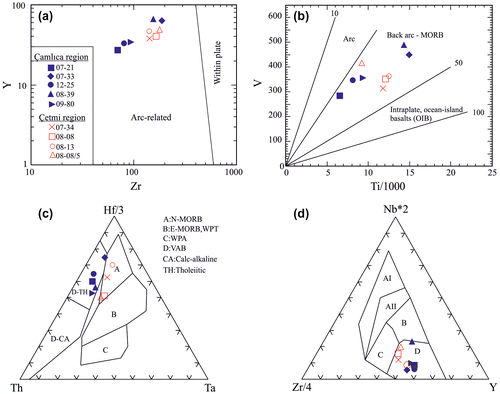
Figure 11. (a) Th/Yb versus Ta/Yb diagram (after Pearce, Citation1982) showing source characteristics for the eclogites. (b) Th/Yb versus Nb/Yb diagram (Pearce, Citation2008).
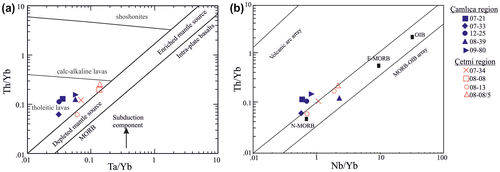
9.3. Tectonometamorphic evolution
The petrological data and mineral chemistry of eclogites from the Biga Peninsula provide insights on the P-T path of the eclogites. The metamorphic evolution of the eclogites, inferred from the petrological data and reaction curves from thermodynamic modeling, is given by the P-T path in Figure . Eclogites from the Çamlıca and Çetmi region exhibit very similar P-T conditions, suggesting that these two portions of the Biga Peninsula record a similar tectonic history (Figure (a) and (b)).
Eclogites occur as tectonic slices within the low-grade metamorphic rocks of the Çamlıca metamorphics. However, the Çamlıca metamorphics record only a single stage of greenschist facies metamorphism and were juxtaposed with the eclogite-facies metamorphic rocks along ductile-semi brittle strike-slip faults (Şengün et al., Citation2011). Eclogite are locally retrogressed to blueschists along these shear zones. The mineral assemblage of eclogite-facies is commonly made up of garnet + omphacite + glaucophane + phengite + epidote + quartz ± Ca- amphibole ± rutile ± titanite. P-T conditions of eclogites have previously been estimated as 11 kbar and 510 ± 50 °C (Okay & Satır, Citation2000a) based on the Fe–Mg exchange between garnet and clinopyroxene (omphacite) (Ellis & Green, Citation1979). Using fresh sample, we present new higher P-T conditions of 16–22 kbar and 550–675 °C using the Holland and Powell (Citation1998) database accessed by PERPLE_X. Preservation of high-P mineral assemblages implies that part of the subducted oceanic crust separated from the descending slab further down the subduction channel than previously thought and that due to the preservation of the eclogite assemblage we interpret that is was subsequently rapidly exhumed, however we have little evidence to shed light on the slope of the P-T path other than blueschist in late-stage shear zones and late greenschist retrograde metamorphism that could have occurred over a steep or relatively relaxed slope.
Eclogites occur as a tectonic slice beneath the Çetmi Group (Tunç, Citation2008; Yiğitbaş et al., Citation2009a, Citation2009b). The mineral assemblage of eclogites is mainly composed of garnet + omphacite + glaucophane + epidote + phengite + quartz ± Ca-amp ± rutile ± titanite ± chlorite ± zircon ± calcite. Garnet-clinopyroxene Fe–Mg geothermometry of Ellis and Green (Citation1979) indicates temperatures of 480 ± 50 °C at a pressure of 10 kbar (Okay & Satır, Citation2000b). Nevertheless, our modeling indicates higher P-T conditions of 17–24 kbar and 575–700 °C. The presence of eclogite within the Çetmi Group shows that it represents a segment of Tethyan (Okay & Satır, Citation2000b) or older (Tunç et al., under review) subduction channel that was exhumed through an accretionary complex.
P-T conditions of HP metamorphism in the Biga Peninsula can be compared to the Rhodope Massif. High-P metamorphism with peak conditions of 585 ± 32 °C and 21.7 ± 1.1 kbar in kyanite eclogite and 619 ± 53 °C and 16.9 ± 1.7 kbar in common eclogite from the Kechros Complex in the eastern Rhodope (Mposkos et al., Citation2012). Moreover, HP/UHP metamorphism has been reported from the Kimi Complex, which has minimum temperature of 800 °C and pressure of 23 kbar (Bauer, Rubatto, Krenn, Proyer, & Hoinkes, Citation2007; Kreen, Bauer, Proyer, Klötzli, & Hoinkes, Citation2010).
10. Concluding remarks
The Biga Peninsula occurring on the westernmost part of the Sakarya Zone contains high-P metamorphic slices/blocks. Geochemical data and mineral chemistry in this study document the protolith, tectonic setting of eclogites and also provide new insights to metamorphism. The geochemical data obtained for eclogites from the Biga Peninsula show that the protoliths were N-type MORB basalts with evidence of volcanic arc affinity to back-arc affinity. Most eclogite protoliths were probably derived from depleted mantle source, modified by the addition of a subduction component. The slab-derived components enriched in LILE intruded into the depleted mantle triggering partial melting of the mantle wedge. The generated melts have MORB-type tholeiitic character.
P-T conditions of eclogites from the Çamlıca and Çetmi region are similar to one another. Regional high-P metamorphism with peak conditions of 550–675 °C and 16–22 kbar in eclogite from the Çamlıca region and 575–700 °C and 17–24 kbar in eclogite from the Çetmi region. The eclogites in the Biga Peninsula represent tectonic slices of subduction channel incorporated into lower-grade metamorphic rocks in an accretionary complex after exhumation from within a subduction zone.
Acknowledgments
This study was supported by the TÜBİTAK project ÇAYDAG 108Y232 and ÇAYDAG 110Y281 and include some results of them. We thank Donna Whitney, Anette von der Handt and Osman Candan for microprobe analyses. The constructive criticism of Nicolay Bonev and Roland Oberhansli is greatly appreciated.
References
- Aygül, M., Topuz, G., Okay, A. I., Satır, M., & Meyer, H. P. (2012). The Kemer Metamorphic Complex (NW Turkey), a subducted continental margin of the Sakarya zone. Turkish Journal of Earth Sciences, 21, 19–35.
- Bauer, C., Rubatto, D., Krenn, K., Proyer, A., & Hoinkes, G. (2007). A zircon study from the Rhodope metamorphic complex, N-Greece: Time record of a multistage evolution. Lithos, 99, 207–228.
- Beccaletto, L. (2004). Geology, correlations and geodynamic evolution of the Biga Peninsula, Northwest Turkey (PhD thesis). University of Lousanne, Switzerland, pp. 1–146.
- Beccaletto, L., Bartolini, A. C., Martini, R., Hochuli, P. A., & Kozur, H. (2005). Biostratigraphic data from Çetmi Melange, Northwest Turkey: Palaeogeographic and tectonic implications. Palaeogeography, Palaeoclimatology, Palaeoecology, 221, 215–244.
- Beccaletto, L., Bonev, N., Bosch, D., & Bruguier, O. (2007). Record of a Palaeogene syn-collisional extension in the North Aegean Sea: Evidence from the Kemer micaschists (NW Turkey). Geological Magazine, 144, 393–400.
- Beccaletto, L., & Jenny, C. (2004). Geology and correlation of the Ezine zone: A Rhodope fragment in NW Turkey? Turkish Journal of Earth Sciences, 13, 145–176.
- Bernard-Griffiths, J., Peucat, J. J., Cornichet, J., Iglesias Ponce de Leon, M., & Iberguchi, J. I. G. (1983). U-Pb, Nd ısotope and REE geochemistry in eclogites from the Cabo Ortegal Complex, Galicia, Spain: An example of REE ımmobility conserving MORB like patterns during high-grade metamorphism. Chemical Geology, 52, 217–225.
- Brique, L., Bougault, H., & Joron, J. L. (1984). Quantification of Nb, Ta, Ti and V anomalies in magmas associated with subduction zones: Petrogenetic implications. Earth and Planetary Science Letters, 68, 257–263.
- Carswell, D. A. (1990). Eclogite-facies rocks. Glasgow and London: Blackie.
- Cavazza, W., Okay, A. I., & Zattin, M. (2009). Rapid early-middle exhumation of the Kazdağ Massif (Western Anatolia). International Journal of Earth Science, 98, 1935–1947.
- Coleman, R. G., Lee, D. E., Beatty, L. B., & Brannock, W. W. (1965). Eclogites and eclogites: Their differences and similarities. Geological Society of America Bulletin, 76, 483–508.
- Connolly, J. A. D. (1990). Multivariable phase-diagrams: An algorithm based on generalized thermodynamics. American Journal of Science, 290, 666–718.
- Connolly, J. A. D. (2005). Computation of phase equilibria by linear programming: A tool for geodynamic modeling and its application to subduction zone decarbonation. Earth and Planetary Science Letters, 236, 524–541.
- Di Vincenzo, G., Palmeri, R., Talarico, F., Andriessen, P. A. M., & Ricci, C. A. (1997). Petrology and geochronology of eclogites from the lanterman range, Antarctica. Journal of Petrology, 38, 1391–1417.
- Duru, M., Pehlivan, Ş., Şentürk, Y., Yavaş, F., & Kar, H. (2004). New results on the lithostratigraphy of the Kazdağ Massif in Northwest Turkey. Turkish Journal of Earth Science, 13, 177–186.
- Ellis, D. J., & Green, D. H. (1979). An experimental study of the effect of Ca upon garnet-clinopyroxene Fe–Mg exchange equilibria. Contributions to Mineralogy and Petrology, 71, 13–22.
- Green, T. H. (1995). Significance of Nb/Ta as an indicator of geochemical processes in the crust-mantle system. Chemical Geology, 120, 347–359.
- Holland, T. J. B., & Powell, R. (1990). An enlarged and updated internally consistent thermodynamic dataset with uncertainties and correlations: the system K2O-Na2O-CaO-MgOMnO-FeO-Fe2O3-Al2O3-TiO2- SiO2-C-H2-O2. Journal of Metamorphic Geology, 8, 89–124.
- Holland, T. J. B., & Powell, R. (1998). An internally consistent thermodynamic data set for phases of petrological interest. Journal of Metamorphic Geology, 16, 309–343.
- Irvine, T. N., & Baragar, W. R. A. (1971). A guide to the chemical classification of the common volcanic rocks. Canadian Journal of Earth Science, 8, 523–548.
- Keller, R. A., Fisk, M. R., Smellie, J. L., Strelin, J. A., Lawver, L. A., & White, W. M. (2002). Geochemistry of back-arc basin volcanism in Bransfield Strait, Antarctica: Subducted contributions and along-axis variations. Journal of Geology, 101, 703–714.
- Koons, P. O., & Thompson, A. B. (1985). Non-mafic rocks in the greenschist, blueschist and eclogite facies. Chemical Geology, 50, 3–30.
- Kreen, K., Bauer, C., Proyer, A., Klötzli, U., & Hoinkes, G. (2010). Tectonometamorphic evolution of the Rhodope orogen. Tectonics, 29(4), 1–25.
- Krogh, E. J. (1980). Geochemistry and petrology of glaucophane-bearing eclogites and associated rocks from Sunnfjord, Western Norway. Lithos, 13, 355–380.
- Leake, B. A., Woolley, A. R., Arps, C. E. S., Birch, W. D., Gilbert, M. C., Grice, J. D., … Youzmi, G. (1997). Nomenclature of amphiboles. Report of the subcommittee on amphiboles of the ınternational mineralogical association commission on new minerals and mineral names. European Journal of Mineralogy, 9, 623–651.
- Lips, A. L. W. (1998). Temporal constraints on the kinematics of the destabilization of an orogen – syn- to post-orogenic extensional collapse of the Northern Aegean region (PhD thesis). Vrije University, Netherlands, Amsterdam.
- Meinhold, G., Kostopoulos, D., Frei, D., Himmerkus, F., & Reischmann, T. (2010). U-Pb LA-SF-ICP-MS zircon geochronology of the Serbo-Macedonian Massif, Greece: Palaeotectonic constraints for Gondwana-derived terranes in the Eastern Mediterranean. International Journal of Earth Science, 99, 813–832.
- Meschede, M. (1986). A Method of discriminating between different types of midocean ridge basalts and continental tholeiites with the Nb-Zr-Y diagram. Chemical Geology, 56, 207–218.
- Michard, A. (1989). Rare earth element systematic in hydrothermal fluids. Geochimica et Cosmochimica Acta, 53, 745–750.
- Morimoto, N., Fabries, J., Ferguson, A. K., Ginzburg, I. V., Ross, M., Seifert, F. A., & Zussman, J. Z. (1988). Nomenclature of pyroxenes. American Mineralogist, 73, 1123–1133.
- Mposkos, E., Baziotis, I., & Proyer, A. (2012). Pressure-temperature evolution of eclogites from the Kechros complex in the Eastern Rhodope (NE Greece). International Journal of Earth Sciences, 101, 973–996.
- Müller, D., Franz, L., Herzig, P. M., & Hunt, S. (2001). Potassic igneous rocks from the vicinity of epithermal gold mineralization, Lihir Island, Papua New Guinea. Lithos, 75, 163–186.
- Okay, A. I., & Göncüoğlu, M. C. (2004). The karakaya complex: A review of data and concepts. Turkish Journal of Earth Science, 13, 77–95.
- Okay, A. I., & Satır, M. (2000a). Upper cretaceous eclogite – Facies metamorphic rocks from the Biga Peninsula, Northwest Turkey. Turkish Journal of Earth Science, 9, 47–56.
- Okay, A. I., & Satır, M. (2000b). Coeval plutonism and metamorphism in a latest Oligocene metamorphic core complex in Northwest Turkey. Geological Magazine, 137, 495–516.
- Okay, A. I., Satır, M., & Siebel, W. (2006). Pre-Alpide and Mesozoic orogenic events in the Eastern Mediterranean region. Memoirs of the Geological Society of London, 32, 389–405.
- Okay, A. I., Siyako, M., & Bürkan, K. A. (1990). Geology and tectonic evolution of the Biga Peninsula. Turkish Association Petroleum Geology Bulletin, 2/1, 83–121.
- Pearce, J. A. (1982). Trace element characteristics of lavas from destructive plate boundaries. In R. S. Thorpe (Ed.), Andesites (pp. 525–548). New York, NY: Wiley.
- Pearce, J. A. (1996). A user’s guide to basalts discriminstion diagrams. In D. A. Wyman (Ed.), Trace element geochemistry of volcanic rocks: Applications for massive sulfide exploration (pp. 79–113). Geological Association of Canada short course notes 12.
- Pearce, J. A. (2008). Geochemical fingerprinting of oceanic basalts with applications to ophiolite classification and the serch for Archean oceanic crust. Lithos, 100, 14–48.
- Pearce, J. A., Baker, P. E., Harvey, P. K., & Luff, I. W. (1995). Geochemical evidence for subduction fluxes, mantle melting and fractional crystallization beneath the South Sandwich arc. Journal of Petrology, 36, 1073–1109.
- Peate, D. W. (1997). The Parana–Etendeka province. In J. Mahoney & M. Coffin (Eds.), Large igneous provinces: Continental, oceanic, and planetary flood volcanism (pp. 217–245). AGU Geophysical Monograph, USA, 100.
- Saunders, A. D., & Tarney, J. (1979). The geochemistry of basalts from a back-arc spreading center in the Scotia Sea. Geochimica et Cosmochimica Acta, 43, 55–72.
- Şengün, F., & Çalık, A. (2007). Metamorphic features and correlations of the Çamlıca Metamorphics (Biga Peninsula, NW Turkey). Geological Bulletin of Turkey, 50, 1–16.
- Şengün, F., Yigitbas, E., & Tunç, İ. O. (2011). Geology and tectonic emplacement of eclogite and blueschist, Biga Peninsula, Northwest Turkey. Turkish Journal of Earth Science, 20, 273–285.
- Shervais, J. K. (1982). Ti–V plots and the petrogenesis of modern and ophiolitic lavas. Earth and Planetary Science Letters, 59, 101–118.
- Smith, D. C. (1988). A review of the peculiar mineralogy of the ‘Nor-wegian coesite–eclogite province’, with crystal-chemical, petrological, geochemical and geodynamical notes and an extensive bibliography. In D. C. Smith (Ed.), Eclogites and eclogite-facies rocks (pp. 1–178). Amsterdam: Elsevier.
- Stern, R. A., Syme, E. C., & Lucas, S. B. (1995). Geochemistry of 1.9 Ga MORB- and OIB-like basalts from Amisk collage, Flin Flon belt, Canada: Evidence for an intra-oceanic origin. Geochimica et Cosmochimica Acta, 59, 3131–3154.
- Sun, S. S., & McDonough, W. F. (1989). Chemical and isotopic systematics of oceanic basalts: İmplications for mantle composition and processes. In A. D. Saunders, & M. J. Norry (Eds.), Magmatism in the Ocean Basins (pp. 313–345). Geological Society of London, UK, Special Publication 42.
- Taylor, S. R., & McLennan, S. M. (1985). The continental crust: Its composition and evolution. Oxford: Blackwell Scientific.
- Tunç, İ. O. (2008). Geology of the Kazdağ Massif rocks on the southern of Bayramiç (Çanakkale) (Master Thesis). Çanakkale Onsekiz Mart University, Çanakkale, Turkey.
- West, D. P., Coish, R. A., & Tomascak, P. B. (2004). Tectonic setting and regional correlation of Ordovician metavolcanic rocks of the Casco Bay Group, Maine: Evidence from trace element and isotope geochemistry. Geological Magazine, 141, 125–140.
- Whitney, D., & Evans, B. W. (2010). Abbreviations for names of rock-forming minerals. American Mineralogist, 95, 185–187.
- Wilson, M. (1989). Igneous petrogenesis – A global tectonic approach. London: Chapman & Hall.
- Wood, D. A. (1980). The application of a Th-Hf-Ta diagram to problems of tectonomagmatic classification and to establishing the nature of crustal contamination of basaltic lavas of the British Tertiary volcanic province. Earth and Planetary Science Letters, 50, 11–30.
- Yaltırak, C., & Okay, A. I. (2004). Geology of the Palaeo-Tethyan Units on the northern of Edremit Bay. Bulletin of Engineering of ITU, 3, 67–79.
- Yiğitbaş, E., Şengün, F., & Tunç, I. O. (2009a). Distrubition and correlation of the Mesozoic rocks associations in the NW Anatolia (p. 118). TÜBİTAK Report, ÇAYDAG108Y232. Retrieved from http://uvt.ulakbim.gov.tr/uvt/index.php?cwid=9&vtadi=TPRJ&ano=125276_70a659d90b7420a322b510c4328d363d
- Yiğitbaş, E., Tunç, I. O., & Şengün, F. (2009b). Some major geological problems in the Biga Peninsula. 62nd Geological Kurultai of Turkey, Abstract Book I, 1, 458–459.
